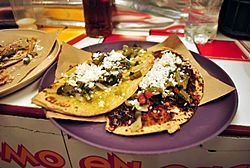Tlacoyo facts for kids

Tlacoyo with green and chile pasilla sauce
|
|
| Type | Pancake |
|---|---|
| Main ingredients | Masa |
A tlacoyo is a tasty, oval-shaped Mexican dish. It's made from a special corn dough called masa. People sometimes call them tlayoyis or clacoyos. Tlacoyos are thicker than regular corn tortillas. They are usually filled with yummy ingredients. These can be cooked beans, cheese, or even fava beans. After being filled, they are fried or toasted.
Tlacoyos can be served in different ways. They might come with soups and stews. They are also popular as appetizers for celebrations. Most traditional tlacoyos are made without lard or salt. This means they can get tough and dry quickly. To keep them warm and moist, vendors in Mexican markets often put them in covered baskets. This dish is quite similar to the Salvadoran pupusa.
What Does "Tlacoyo" Mean?
The name tlacoyo comes from an old language. It's a changed version of the Nahuatl word tlahtlaōyoh. This name was given to a type of Mexican street food called an antojito. This food is very common in central Mexico.
How People Enjoy Tlacoyos
Tlacoyos are shaped a bit like a smaller version of a huarache. They are also made from the same corn dough as a sope. Tlacoyos are even thicker than sopes. This makes them great for holding wet toppings.
Sometimes, street vendors in Mexico City sell tlacoyos with toppings. This is an alternative to sopes and huaraches. However, the traditional way to eat a tlacoyo is simple. It's usually enjoyed with just fresh salsa on top. This is how you will often find them sold on the streets.
The Colors of Tlacoyos
Tlacoyos come in three different colors. No artificial colors are added to make them this way. The color comes from the type of cornmeal used. This cornmeal is what the masa is made from. The most common color is blue. This blue masa comes from blue corn kernels.
- Tlacoyo
-
A tlacoyo made from blue corn meal.
-
A woman making tlacoyos on the sidewalk in Colonia Condesa in Mexico City. The tlacoyo is cooked on a comal. This comal is placed over an anafre, which is a type of coal stove. People in Mexican homes often use these stoves if they don't have other heating energy.
See also
 In Spanish: Tlacoyo para niños
In Spanish: Tlacoyo para niños



